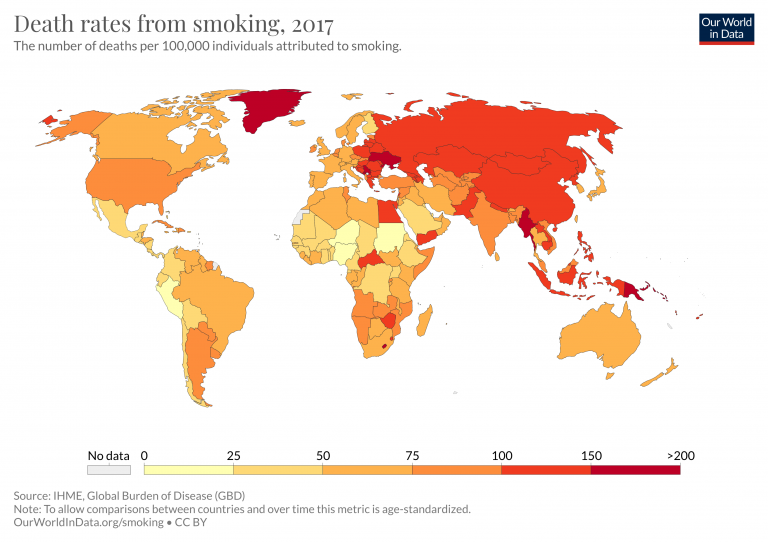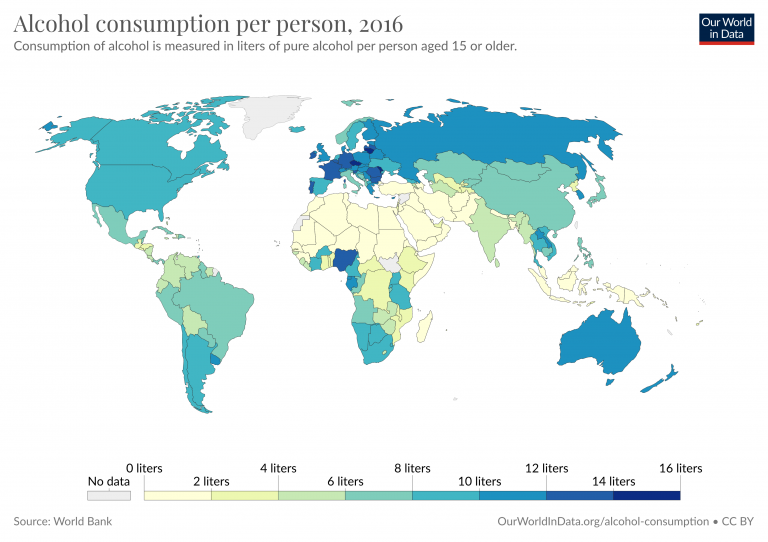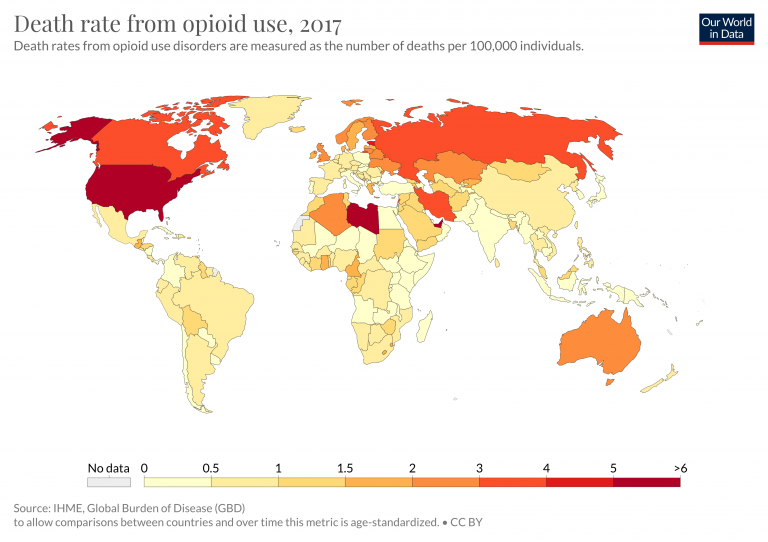In this entry we are looking at smoking, alcohol consumption and the use of illicit drugs. We are studying who is using these substances, how their use has changed over time, and we are presenting the estimates of their impact on health.
Collectively, smoking, alcohol and illicit drug use kills 11.8 million people each year. This is more than the number of deaths from all cancers.1
We look at smoking, alcohol and illicit drugs separately in dedicated research articles. But in this meta-article we look at the combined impacts of substance use: both through indirect impacts on mortality and direct consequences from addiction and overdoses.
Support for substance use disorders
At the end of this entry you will find additional resources and guidance if you, or someone you know needs support in dealing with a substance use disorder.
Summary
- Drug use is directly and indirectly responsible for 11.8 million deaths each year.
- Smoking, alcohol and drug use is an important risk factor for early death: 11.4 million die prematurely as a result each year.
- Over 350,000 die from overdoses (alcohol and illicit drug use disorders) each year.
- Substance use disorders are much more common in men.
- More than half of those who die from alcohol or drug overdoses are younger than 50.
- 1.5% of global disease burden results from alcohol and illicit drug addiction; in some countries it’s over 5%.
Related research entries
Alcohol consumption – How has alcohol consumption changed over time? What are the health impacts?
Illicit drug use – Illicit drugs are those that have been prohibited under international drug control treaties. They include opioids, cocaine, amphetamines and cannabis. How common is drug addiction across the world? Where has overdoses become more common?
Smoking – Tobacco smoking is not considered to be a substance use disorder, but does have a large death toll in terms of indirect deaths from other diseases. How much do people smoke across the world? What are the health implications?
Total deaths
How many people die from substance use each year?
To answer this, we need to define two aspects: (1) what substances i.e. drugs do we include in this definition; and (2) what do we mean by a death caused by substance use – does this include only direct deaths (i.e. drug overdoses) or also the increased risk of premature death from moderate, long-term drug use?
The Global Burden of Disease is a major global study on the causes and risk factors for death and disease published in the medical journal The Lancet.2,3
The Global Burden of Disease study identifies and provides estimates for substance use deaths through both pathways. The first is a direct death from a ‘substance use disorder’. A substance use disorder is characterized by meeting the criteria for drug dependence as defined by the World Health Organization’s International Classification of Diseases (ICD-10).4 Alcohol dependence or illicit drug dependence (which includes opioids, cocaine, amphetamines and cannabis) are included in substance use disorders; deaths from these disorders can be considered drug overdoses, with the terms being used interchangeably in the study literature.5
The second pathway is indirect: drug use can increase the risk of premature from a range of causes.6 Alcohol and illicit drug use, for example, increases the risk of premature death from diseases and injury, including suicide, liver disease, hepatitis, and HIV. Smoking is a key risk factor for lung and other forms of cancer, heart disease, stroke and diabetes.
In the visualization we summarize the results of the Global Burden of Disease study on the number of deaths attributed to substance use: this is differentiated between indirect deaths as a risk factor from smoking, alcohol and illicit drug use (shown in blue) and direct deaths from substance use disorders of alcohol and illicit drugs (in red).
Globally, substance use was responsible for 11.8 million deaths in 2017. This is one in five deaths globally.7
We see that premature deaths from smoking is the large contributor to this. Overall, premature deaths from substance use greatly outnumber direct deaths from overdoses.
Indirect deaths: risk factors for early death
11.8 million deaths are attributed to substance use each year – we look at the this breakdown between direct deaths (from drug overdoses) and indirect deaths from increased risk of various diseases and injury here.
What we see from this breakdown is that the majority of these deaths are indirect: they result from more than smoking increasing the risk of lung and various other cancers, heart disease, stroke and diabetes; and alcohol and illicit drugs increasing the risk of suicide, hepatitis and liver diseases.
The Global Burden of Disease is a major global study on the causes and risk factors for death and disease published in the medical journal The Lancet.8 These estimates of the annual number of deaths attributed to a wide range of risk factors are shown here. This chart is shown for the global total, but can be explored for any country or region using the “change country” toggle.
In this chart you see deaths from smoking, secondhand smoke, alcohol use, and drug use: collectively these accounted for 11.4 million deaths in 2017. If we consider these deaths collectively, this makes substance use the leading risk factor for premature death globally.
Direct deaths: drug overdoses
As we have just seen most deaths from substance use are the result of long-term use of the drugs which increases the likelihood of various diseases and injury: these are indirect deaths caused by the drugs.
But a significant number of people die every year from directly from drug overdoses. ‘Substance use disorders’ are classified on the basis of drug dependency, as defined by the criteria in the WHO’s International Classification of Disease (ICD-10).
Deaths from substance use disorders are differentiated between alcohol dependence, and illicit drug dependence (which includes opioids, cocaine, amphetamines and cannabis).
These estimates of the annual number of deaths by cause are shown here. This chart is shown for the global total, but can be explored for any country or region using the “change country” toggle.9
Just over 350,000 died from substance use disorders in 2017: 185,000 from alcohol, and 167,000 from illicit drugs.
In some countries drug overdoses rank highly on the leading causes of death: in the USA in 2017, for example, more people died from overdoses than in road accidents.
Prevalence of substance use disorders
How common is alcohol or drug addiction?
In the map here we see the share of the population with a ‘substance use disorder’. Globally, just over 2% of the world were dependent on alcohol or an illicit drug.
In some countries it’s even more common. In the USA and several countries in Eastern Europe, more than 1-in-20 (5%) were dependent. In the USA, this was dominated by illicit drug dependence, whereas alcoholism was much more common in Russia and Eastern Europe.
How does the prevalence of substance use disorders – alcohol and illicit drug addiction – vary between men and women?
In this visualization we show this comparison: the share of men with a substance use disorder is shown on the y-axis; the share of women on the x-axis. The grey line represents parity: countries which lie along this line have equal prevalence in men and women. In countries which lie above the line, substance use disorders is more common in men.
Globally, alcohol or drug dependence was twice as common in men as in women: in 2016, 2.4% of men were dependent, versus 1.2% in women. Since all countries lie above the grey line, dependency is more common in men across the world.
Do countries with high rates of alcoholism also have high rates of other drug use disorders? Or does a high prevalence in one mean a low prevalence in the other?
In the chart we see the share of the population with alcohol dependency versus the share with a drug use disorder (not including alcohol or tobacco).
There is no clear universal relationship between the two; whilst most countries have a higher prevalence of alcohol dependence relative to other drugs, this is not true for all countries. It is also the case that a given country having a high rate of alcoholism does not imply it also has high rates of other drug use disorders (or vice versa).
Overall we see two clear outliers: Russia has notably high rates of alcoholism, and the United States high prevalence of other drug addiction.
Deaths from substance use disorders
In the visualization we see the breakdown of deaths from substance use disorders by substance type. Note that these figures include only direct deaths from drug dependence.
Collectively, all substances shown in red are classified as ‘illicit drugs’.
We see that globally alcohol has the highest death toll amongst substance use disorders. Deaths from opioid overdoses have increased significantly in recent years and now exceed 100,000 globally.
This data can be explored for any country or region using the “change country” toggle on the interactive chart.
In the interactive visualization we see death rates from alcohol and drug use disorders, measured as the number of deaths per 100,000 individuals.
We see much higher rates in the USA and across several countries in Eastern Europe. In the USA, this was dominated by illicit drug dependence, whereas alcoholism was much more common in Russia and Eastern Europe.
Related charts – number of deaths from substance use disorders. This map shows the number of deaths from substance use disorders each year. This chart shows the breakdown of annual deaths between alcohol and illicit drug use disorders.
Many premature deaths from substance use as a risk factor for diseases and injury occurs in older individuals – for example, most people who die from smoking are over 70 years old. For substance use disorders, it is often younger demographics who are most likely to die.
In the chart we see the breakdown of deaths from substance use disorders by age. Here we that the largest number of deaths – more than half – kill people who were younger than 50 years.
Disease burden from substance use disorders
Using the measure of deaths fails to capture the full health consequences of substance use disorders. Drugs not only lead to death, but also to diseases and disabilities that impact people’s health.
To quantify full health impacts we can look at ‘disease burden‘, measured in Disability-Adjusted Life Years; DALYs. This metric considers not only death rates, but also years lived with disability or health burden.
In the map we see the share of disease burden attributed to substance use disorders. 1.5% of global disease burden is attributed to alcohol and illicit drug addiction.
In some countries this share is much higher: in the USA it accounts for more than 5% of disease burden.
Substance use disorder, also known as substance dependence, is defined by the IHME based on the definition within the WHO’s International Classification of Diseases (ICD-10).10 Substance use disorders include alcohol and all illicit drugs (whether prescribed or otherwise) including opioids, cocaine, amphetamine and cannabis.
The IHME classification does not include tobacco – the health burden as a result of tobacco smoking is discussed in our entry on smoking.
A definite diagnosis of dependence should usually be made only if three or more of the following have been present together at some time during the previous year:
- (a) a strong desire or sense of compulsion to take the substance;
- (b) difficulties in controlling substance-taking behaviour in terms of its onset, termination, or levels of use;
- (c) a physiological withdrawal state when substance use has ceased or been reduced, as evidenced by: the characteristic withdrawal syndrome for the substance; or use of the same (or a closely related) substance with the intention of relieving or avoiding withdrawal symptoms;
- (d) evidence of tolerance, such that increased doses of the psychoactive substance are required in order to achieve effects originally produced by lower doses (clear examples of this are found in alcohol- and opiate-dependent individuals who may take daily doses sufficient to incapacitate or kill nontolerant users);
- (e) progressive neglect of alternative pleasures or interests because of psychoactive substance use, increased amount of time necessary to obtain or take the substance or to recover from its effects;
- (f) persisting with substance use despite clear evidence of overtly harmful consequences, such as harm to the liver through excessive drinking, depressive mood states consequent to periods of heavy substance use, or drug-related impairment of cognitive functioning; efforts should be made to determine that the user was actually, or could be expected to be, aware of the nature and extent of the harm.
Illicit drugs include plant-based drugs – such as cocaine and cannabis; synthetic drugs – such as amphetamines; and pharmaceutical drugs – such as heroin and other opioids and benzodiazepines.
- Data: Deaths, DALYs and prevalence of mental health and substance use disorders, by age and sex
- Geographical coverage: Global by country and region
- Time span: 1990 – 2016
- Available at: http://ghdx.healthdata.org/gbd-results-tool
World Health Organization. (1992). The ICD-10 classification of mental and behavioural disorders: clinical descriptions and diagnostic guidelines (Vol. 1). World Health Organization.
- Data: Definitions and classifications of mental and substance use disorders
- Available at: ICD-10 Classification of Mental and Behavioural Disorders
- Data: Prevalence of substance use disorders, trends in alcohol consumption
- Geographical coverage: Global by country
- Time span: Variable depending on datasets. Most inconsistent years post-2000
- Available at: http://www.who.int/gho/en/
- Information: Guidance and support on treatment. Specific guides for teens, young adults and adults, as well as those trying to support someone with a drug use disorder.
- Geographical coverage: Universal guidance; US-based treatment
- Available at: https://www.drugabuse.gov/related-topics/treatment
- Information: Guidance and support on where to get help with a drug use disorder
- Geographical coverage: UK only
- Available at: https://www.nhs.uk/livewell/drugs/pages/drugtreatment.aspx
- Information: Free, confidential support services online, and by phone. General information ranging from drug effects to support for a drug dependency.
- Geographical coverage: Global
- Available at: http://www.talktofrank.com/
- Information: Guidance from the World Health Organization (WHO) for healthcare providers managing women from conception to birth and the postnatal period, and their infants.
- Geographical coverage: Global
- Available at: WHO Guidance


